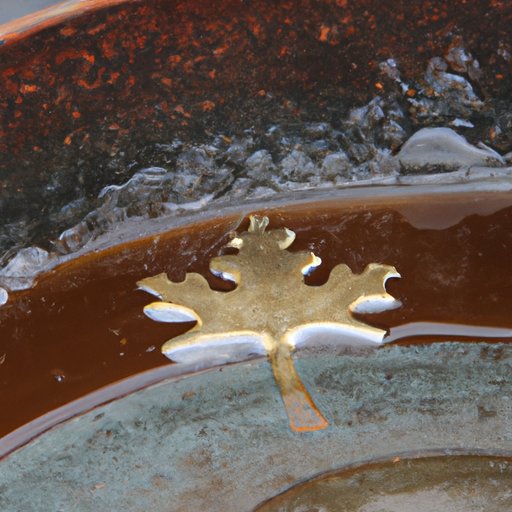I. Introduction
Maple syrup is a delightful, all-natural sweetener with a history dating back centuries. If you’re interested in making your own maple syrup, you’re in luck! In this article, we’ll walk you through the process, discuss equipment needs, and offer tips on flavoring and health benefits. Get ready to tap some trees!
II. A Step-by-Step Guide to Making Maple Syrup
The process of making maple syrup is simple but requires some patience. Here’s a step-by-step guide to get you started:
- Choose the right trees: Sugar maple, red maple, and black maple trees are all good options.
- Tap the trees: Drill a hole in the tree and insert a spout or tap. Collect the sap in a bucket or tubing.
- Boil down the sap: Use a large pot or evaporator to boil the sap down to syrup consistency. This can take several hours.
- Filter and bottle the syrup: Strain the syrup through a filter and bottle it for storage.
Remember that you’ll need a substantial amount of sap to produce a small quantity of syrup – roughly 40 gallons of sap boil down to one gallon of syrup.
III. Equipment Needed for Making Maple Syrup
There are many options for equipment when it comes to making maple syrup. Traditionalists may prefer buckets and spouts, while others may opt for more modern options with tubing and taps. Here are some things to consider:
- Buckets and spouts: These traditional options require frequent checks for collection and may be more time-consuming.
- Tubing and taps: These more modern options can be more efficient, with sap flowing directly into a collection container, but require a larger upfront investment.
- Large pot or evaporator: Choose a pot or evaporator large enough to handle the volume of sap you’ll be processing. This can be purchased or made at home.
- Filtering equipment: Use a filter to remove impurities from the syrup after boiling.
Whichever option you choose, make sure to properly clean and maintain your equipment to ensure its longevity.
IV. Different Grades of Maple Syrup
Not all maple syrup is created equal! Grades of syrup are determined by its color and flavor, and each has its own unique sweetness level. Here are the four main grades of maple syrup:
- Golden/delicate: Light in color and mild in flavor. Best used for pouring over pancakes and waffles.
- Amber/rich: A bit darker and more flavorful than golden syrup. Great for cooking and baking.
- Dark/robust: Darker in color and stronger in flavor. Ideal for use in savory dishes or for those looking for a bold maple taste.
- Very dark/strong: Darkest in color and strongest in flavor. Rarely used for table syrup, but great for cooking and flavoring.
When choosing a grade of syrup, consider what you’ll be using it for and what flavor profile you prefer.
V. Making Maple Candy
If you’re looking for a fun spin on traditional maple syrup, try making maple candy! Here’s how to do it:
- Boil the syrup to the right temperature: You’ll want the syrup to reach between 235-245 degrees Fahrenheit to ensure proper candy-making consistency.
- Shape and cool the candy: Pour the syrup into molds or shape it by hand, then allow it to cool and harden.
- Enjoy the results: Maple candy makes for a delicious treat on its own or chopped up and used as a topping.
Remember to use caution when handling hot syrup to avoid burns!
VI. Flavoring Maple Syrup
While maple syrup is delicious on its own, there are many ways to experiment with different flavor combinations. Here are some ideas for flavoring homemade syrup:
- Add spices such as cinnamon, nutmeg, or allspice.
- Mix in fruit juices or zest for a citrusy twist.
- Infuse with alcohol such as whiskey or bourbon for a deeper, smokier flavor.
Experiment with different flavors to find your favorites!
VII. Maple Syrup and Health
Maple syrup is often touted as a healthier, more natural alternative to table sugar. While it’s still a sweetener and should be consumed in moderation, here are some possible health benefits:
- Contains antioxidants: Maple syrup is a good source of antioxidants, which can help protect cells from damage.
- May have anti-inflammatory properties: Some studies suggest that maple syrup may have anti-inflammatory effects.
- Lower glycemic index: Maple syrup has a lower glycemic index than table sugar, meaning it won’t cause as rapid a spike in blood sugar levels.
Remember that maple syrup is still a sweetener and should be consumed in moderation. Consult with a healthcare professional before making any major dietary changes.
VIII. Maple Syrup Regionality
While maple syrup can be made in many different regions, there are some areas of the world known for producing particularly high-quality syrup. Here are a few:
- Eastern Canada: Quebec and Ontario are two of the largest areas for maple syrup production, with a long and proud history of syrup-making.
- Northwestern United States: Vermont, New Hampshire, and Maine are known for producing high-quality syrup that’s often used in gourmet cooking.
- Europe: While less well-known for syrup production, European countries such as France and Austria produce their own unique takes on maple syrup.
Each region has its own unique cultural significance and flavor profile, so don’t be afraid to experiment!
IX. Conclusion
Making maple syrup is a fun and rewarding experience that can yield delicious results. From selecting the right equipment to experimenting with different flavor combinations, there are many ways to make maple syrup your own. We hope this guide has been helpful in getting you started!
Now that you know all about making maple syrup, it’s time to hit the trees.
